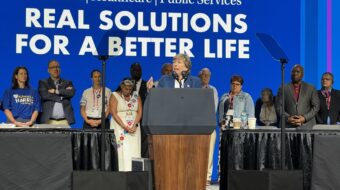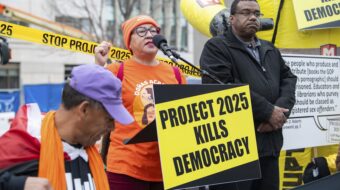
SEATTLE—Washington state is putting Amazon on trial for worker injuries, especially ergonomic—musculoskeletal disorder—injuries at three of the retail giant’s warehouses in Sumner, Kent, and DuPont, Wash.
Technically, the “trial” is a hearing by the state Board of Industrial Insurance Appeals, as the monster warehouser and retailer is appealing some $49,000 in fines the Washington Department of Labor and Industries levied for rampant job safety and health violations at the warehouses.
But complete with expert testimony, witnesses—the experts and the workers—lawyers and evidence, it certainly looks like a trial.
Amazon, which employs 750,000 people and is owned by one of the nation’s three richest people, Jeff Bezos, has a horrifying safety record at its warehouses, with injury rates up to double those of the sector as a whole.
And apparently, conditions at the three Amazon warehouses in Washington are even worse, according to experts and workers testifying at the hearings in Seattle and Tacoma. The trial began July 25 and is scheduled to run through August 10.
They’re so bad, Amazon warehouse workers “told inspectors that pushing through pain was the norm, with some 40% saying they’d experienced it in the previous seven days. Of those, two-thirds said they took medication to ease symptoms.”
While it’s not in the inspection report, the pro-worker Washington Law Center reports Amazon overall has a non-fatal job injury rate of 7.7 per 100 workers. That’s double the rate for the warehouse industry. In 2019, the center added, the DuPont warehouse led the country in injuries: 22 per 100 workers.
The Washington state trial is also notable because Amazon’s lousy national safety record, in combatting the coronavirus, in ergonomic injuries, and in other hazards, led to unionization campaigns among its exploited workers. They’re among the low-paid, overworked, oppressed masses of workers nationwide who have had it up to here with corporate greed and rebelled by union organizing.
As a result, the independent Amazon Labor Union capitalized on Amazon’s failure to even inform its workers about coronavirus outbreaks, and its illegal firing of Chris Smalls for leading a lunchtime walkout about the issue from Amazon’s JFK8 warehouse on Staten Island, N.Y.
Smalls and his colleagues founded the ALU and decisively won a later National Labor Relations Board-run vote at JFK8, pounding away on health and safety issues. ALU has used ergonomic hazards in a similar campaign at a warehouse south of Albany, N.Y.
In their written report to the state Department of Labor and Industries (DLANDI), three outside experts—MDs David Rempel and Robert Harrison, who also have master’s degrees in public health, and Ph.D. Carisa Adamson—reveal horrifying working conditions at the three warehouses.
They also reported Amazon’s safety and health overseers recommended measures to shift the burden of keeping workers safe away from the company and to the workers. Under federal job safety law, which applies to the states, too, the company must shoulder the load, and the blame.
Many job tasks “exposed workers to high levels of biomechanical factors known to increase the risk of musculoskeletal disorders,” their summary begins, and conditions go downhill from there.
“The rates and severity of the recorded musculoskeletal injuries at the DuPont and Kent warehouses over the past five years exceed non-Amazon warehouse industry rates and are consistent with the high biomechanical exposures measured during our site visits.
“Observed hazards include excessive rates and loads of lifting, pulling, gripping, and pinching, and an unsafe pace of work. Overall, 10 of 12 processes analyzed posed hazardous risk for musculoskeletal injuries. The risk from the biomechanical hazards at both Kent and DuPont exceeded levels known by the medical and scientific community to be safe.
“The patterns of musculoskeletal injuries at Kent and DuPont are consistent with those found in the medical literature to be caused or aggravated by the biomechanical hazards.”
But the work itself wasn’t the only hazard to the workers. So was the pace, the three reported. “The rate” at Kent and DuPont “often exceeded the limits of risk assessment tools” they used.
“Essentially, this means that based on the pace of work alone, many jobs would be unsafe. For example, workers unloading and loading trailers lifted and moved boxes”—many of them weighing at least 50 lbs.—“at rates that exceeded the allowable frequency of lifts” according to federal standards.
Even if the workers held the boxes “at waist height and close to the body” as standards call for, “the rate of lifting would classify this as hazardous.” Ten-hour shifts and mandatory overtime in six-day work weeks only made conditions and the risk of ergonomic injuries even worse.
“Productivity measurements, such as ‘time off task,’ penalize workers and discourage them from taking breaks that could help them recover from the high pace of work and other biomechanical exposures. The penalties applied when not meeting productivity demands can also increase stress associated with an increased risk of musculoskeletal injuries,” the three experts reported.
Monthly safety meeting minutes at Kent show Amazon bosses knew what was going on and the high risk of injuries. Their response was “to train the workers in body mechanics,” commonly known as lifting techniques, “such as lift with your legs and not with your back.”
Except body mechanics don’t reduce injuries. And emphasizing them also shifts responsibility for injury prevention from the company to the worker, the report notes. That’s contrary to the Occupational Safety and Health Act’s mandate that job safety is the employer’s responsibility.
“This approach of blaming the workers for their injuries and not addressing the risks of the work demanded of them is especially troubling,” the three experts said laconically. They also identified many safety measures Amazon could implement fast and cheaply to reduce the injury risk to its workers. It hasn’t, which is why the state agency hit it with the fines.
We hope you appreciated this article. At People’s World, we believe news and information should be free and accessible to all, but we need your help. Our journalism is free of corporate influence and paywalls because we are totally reader-supported. Only you, our readers and supporters, make this possible. If you enjoy reading People’s World and the stories we bring you, please support our work by donating or becoming a monthly sustainer today. Thank you!












Comments